Entry Database : PDB / ID : 8a9gTitle Binary complex of 14-3-3 zeta Glucocorticoid Receptor (GR) pT524 peptide stabilised by (R)-para chloropyrrolidone1 14-3-3 protein zeta/delta Glucocorticoid receptor Keywords / / / / / / / / Function / homology Function Domain/homology Component
/ / / / / / / / / / / / / / / / / / / / / / / / / / / / / / / / / / / / / / / / / / / / / / / / / / / / / / / / / / / / / / / / / / / / / / / / / / / / / / / / / / / / / / / / / / / / / / / / / / / / / / / / / / / / / / / / / / / / / / / / / / / / / / / / / / / / / / / / / / / / / / / Biological species Homo sapiens (human)Method / / / Resolution : 1.961 Å Authors Munier, C.C. / Edman, K. / Perry, M.W.D. / Ottmann, C. Funding support European Union, 1items Organization Grant number Country European Commission 675179 European Union
Journal : J.Med.Chem. / Year : 2022Title : Designing Selective Drug-like Molecular Glues for the Glucocorticoid Receptor/14-3-3 Protein-Protein Interaction.Authors : Pallesen, J.S. / Munier, C.C. / Bosica, F. / Andrei, S.A. / Edman, K. / Gunnarsson, A. / La Sala, G. / Putra, O.D. / Srdanovic, S. / Wilson, A.J. / Wissler, L. / Ottmann, C. / Perry, M.W.D. / O'Mahony, G. History Deposition Jun 28, 2022 Deposition site / Processing site Revision 1.0 Dec 28, 2022 Provider / Type Revision 1.1 Jan 4, 2023 Group / Category / citation_authorItem _citation.journal_volume / _citation.page_first ... _citation.journal_volume / _citation.page_first / _citation.page_last / _citation_author.identifier_ORCID Revision 1.2 Jan 31, 2024 Group / Refinement descriptionCategory / chem_comp_bond / pdbx_initial_refinement_modelRevision 1.3 Nov 13, 2024 Group / Category / pdbx_modification_feature / Item
Show all Show less
 Yorodumi
Yorodumi Open data
Open data Basic information
Basic information Components
Components Keywords
Keywords Function and homology information
Function and homology information Homo sapiens (human)
Homo sapiens (human) X-RAY DIFFRACTION /
X-RAY DIFFRACTION /  SYNCHROTRON /
SYNCHROTRON /  MOLECULAR REPLACEMENT / Resolution: 1.961 Å
MOLECULAR REPLACEMENT / Resolution: 1.961 Å  Authors
Authors Citation
Citation Journal: J.Med.Chem. / Year: 2022
Journal: J.Med.Chem. / Year: 2022 Structure visualization
Structure visualization Molmil
Molmil Jmol/JSmol
Jmol/JSmol Downloads & links
Downloads & links Download
Download 8a9g.cif.gz
8a9g.cif.gz PDBx/mmCIF format
PDBx/mmCIF format pdb8a9g.ent.gz
pdb8a9g.ent.gz PDB format
PDB format 8a9g.json.gz
8a9g.json.gz PDBx/mmJSON format
PDBx/mmJSON format Other downloads
Other downloads 8a9g_validation.pdf.gz
8a9g_validation.pdf.gz wwPDB validaton report
wwPDB validaton report 8a9g_full_validation.pdf.gz
8a9g_full_validation.pdf.gz 8a9g_validation.xml.gz
8a9g_validation.xml.gz 8a9g_validation.cif.gz
8a9g_validation.cif.gz https://data.pdbj.org/pub/pdb/validation_reports/a9/8a9g
https://data.pdbj.org/pub/pdb/validation_reports/a9/8a9g ftp://data.pdbj.org/pub/pdb/validation_reports/a9/8a9g
ftp://data.pdbj.org/pub/pdb/validation_reports/a9/8a9g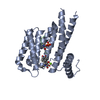
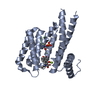
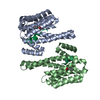
 F&H Search
F&H Search Links
Links Assembly
Assembly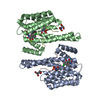
 Components
Components Homo sapiens (human) / Gene: YWHAZ / Plasmid: pProEx Htb / Production host:
Homo sapiens (human) / Gene: YWHAZ / Plasmid: pProEx Htb / Production host: 
 Homo sapiens (human) / References: UniProt: P04150
Homo sapiens (human) / References: UniProt: P04150
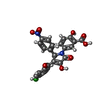





 X-RAY DIFFRACTION / Number of used crystals: 1
X-RAY DIFFRACTION / Number of used crystals: 1  Sample preparation
Sample preparation SYNCHROTRON / Site:
SYNCHROTRON / Site:  SLS
SLS  / Beamline: X06SA / Wavelength: 1.00003 Å
/ Beamline: X06SA / Wavelength: 1.00003 Å Processing
Processing MOLECULAR REPLACEMENT
MOLECULAR REPLACEMENT Movie
Movie Controller
Controller



 PDBj
PDBj





















